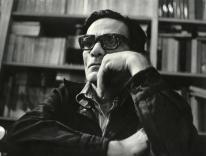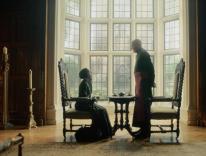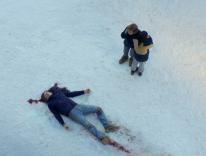When I was leaving the Jesuit novitiate and assigned to teach high school, my novice master told me: “Remember St. Ignatius’s dictum: always go in their door and bring them out yours.” Although I am now a university professor, the phrase has been with me during a Lenten and Easter season in which the main topic of conversation has been Mel Gibson’s The Passion of the Christ. Whether with friends, family, or colleagues, it seems that all of us must go through a ritual conversation on the film. There have been hundreds of articles on The Passion in the secular and religious press, each with a bit of new information or an interesting critical perspective. Many have been helpful in articulating the theological and aesthetic strengths and weaknesses of the film.
Loyola University Chicago recently held an excellent panel discussion on The Passion. A Bible scholar critiqued the film’s historical and scriptural accuracy; a Jewish professor responded to the film’s alleged anti-Semitism; and two doctoral students in theology-an Evangelical Christian minister and a Catholic laywoman-offered their own thoughts. (He praised it, albeit with reservations, while she was very disturbed by it.) The panel was well attended by undergraduates and some neighbors from around the university. During the question period, most of the student audience voiced strong, positive reactions to the film that often seemed at odds with the critical tone of the scholarly participants. Although the panel’s conclusions seemed sound to me-that the movie is not biblically accurate, that it at least flirts with anti-Semitism, that it overindulges in violence-I wondered why the panelists’ remarks were so out of sync with the experience of most of the students. As I continued the discussion in the classroom, it was obvious that my students couldn’t understand why the criticism of the film failed to recognize that it was, in one student’s words, “a sacred event” in their lives. They didn’t want to hear what was wrong with the film, but challenged me to articulate why it was so popular with young people. I began wondering, Why does Generation Y (those born after 1981) see this film so differently from their elders? Is there a way for me, a thirty-nine-year-old professor of English and theology, to go in their cultural door and bring them out my own?
This led to a class project. I asked my students a range of questions about the film, from the portrayal of Mary, Jesus, Judas, and Satan, to its alleged anti-Semitism. What follows is a summation of some of their more articulate responses to three questions: Was it a spiritual experience for you? What do you make of the violence? And, How do you make sense of the aesthetics of the film?
It is clear that for most of these students Gibson’s rendition of the Passion was a spiritual experience. All but a few students noted how deeply moved they were while watching it. “I doubt that seeing it will make converts,” wrote one, “but its sheer in-your-face force has the power to renew one’s faith.” Another added, “It didn’t teach me much about Jesus-I already knew the story-but it did succeed in making me present to the story in ways that I might never have been.” And one wrote, “Although I am a Muslim student and do not view Christ in the same light as Christians, I was deeply moved by the violence that befell Christ.”
For many of these students, the film was analogous to a liturgical experience. They saw it more as a ritual than a biblical history lesson. Catholic film critics and theologians have commented on how closely the film resembles medieval Passion plays or the Catholic devotion of the Stations of the Cross, a ritual that many older Catholics grew up performing during Lent. Cinematically, the film invites the viewer on the same journey. A young woman made this connection in an e-mail: “My youth group in high school put on performances of the Stations of the Cross. I often noticed that the older members of the church were moved and touched more by the story we were acting than the younger members of the parish...[so] I think it was watching the violence in The Passion that helped me get deeper into the story in a way that I never had before.” This sense of the film as “liturgical” was highlighted by a young man who had made two Kairos retreats at his Jesuit high school. He noted that “the film was like Kairos, as if we were in God’s time. It seemed like time had stopped. When the film ended I had no idea that over two hours had passed. It felt like half an hour.”
Most interesting were responses to the violence in The Passion, especially the twenty-minute scourging scene. A young man noted, “The scene was very draining to watch and I was unable to stomach some parts of it, and I am a guy used to watching gory, violent movies. It borders on the sadistic because most movie violence doesn’t deal with a completely defenseless person being beaten half to death.” A young woman went further, claiming, “I have been desensitized to some degree by the amount of violence I’ve been shown throughout my life. Movie violence has progressively increased to thrill and heighten the shock value in order to keep our appetites satisfied.” Why then, she asks, is this film’s violence different? “If The Passion were completely fiction, I wouldn’t care much about the violence. I would have compared the thirty-nine lashes to the decapitations I saw in Kill Bill and the gruesome murders in Pulp Fiction. But the impact of this violence is different-Christ was scourged, Christ was brutalized.”
Gibson’s use of violence seems to be the primary reason why these students find the film engrossing. The violence takes them somewhere, moves them in some way. In a New York Times essay (February 28), novelist Mary Gordon noted that the film’s screenwriter, Benedict Fitzgerald, is the son of the late Sally Fitzgerald. His mother had been the great friend, editor, and biographer of Flannery O’Connor, that most Catholic of modernists who used violence and the grotesque to deconstruct modern assumptions about religious faith and belief. Through violence, O’Connor was able to startle the reader into seeing a new and more sober vision of God’s grace at work. O’Connor insisted that her use of violence is “strangely capable of returning my characters to reality and preparing them to accept their moment of grace.” My students recognized just such an aesthetic in The Passion-though when asked to describe it, they were at pains to articulate what exactly it might mean.
Most students said that the usual presentation of violence in movies and television left them unprepared for the focused, violent confrontations in Gibson’s film. One junior noted that “having grown up with a kind of cleaned up, Hanna-Barbera version of the Passion of Jesus during my Catholic grade-school and high-school education, it was at first hard to watch something this realistic. At the same time, it made me realize how brutal Christ’s scourging and crucifixion were.” Another student stated bluntly: “I don’t know why there is such a fuss over the violence. If there is too much blood in this film, then there is too much blood in the Bible. If we can see mountains of bodies and rivers of blood in Hollywood movies whose purpose seems to glorify violence as a part of life, then it seems obvious that the violence in [this film] indicts such violence.” One conclusion, at least for these students, is that Gibson’s aesthetic is not over the top, not violence as mere spectacle. Though an older generation may find Gibson’s use of violence overbearing and indulgent, many younger people see it as part of the cultural zeitgeist.
One of the most interesting and thoughtful responses on the violence in the film came from a sophomore who dubbed Gibson’s vision an “aesthetic of brutal realism.” He noted, “The violence tears away all other emotions you might get out of violence in our culture. It is focused on one person and there is no way it can be entertaining. If it starts out as a thrill, it quickly moves to shock, and you’re left with only a terrible sense of sadness, of loss. The only thing left for you to do is to stay watching, to bear witness.” There is something profoundly true in this statement. The dramatic depiction of violence is part of the cultural experience of many young people. It thrills, shocks, and entertains, but usually from the safe, ironic distance of print, film, or video games. Gibson’s Passion is a bloodied tragedy that has never before been so compellingly realized on film. There is little space for a postmodern, ironic gaze; instead, the viewer is asked to stand and watch. For several students, that meant watching the movie through Mary’s eyes. “Mary helped to put a personality to Jesus more than any other character in the film,” a senior wrote. “We enter from her position. She is there from the beginning until the end of Jesus’ life.” Added another: “Without Gibson panning to [Mary], it would have been hard to keep watching.”
Whatever the cinematic merits, historical accuracy, or theological vision of the film, it must be said that it has made students think. Indeed, that seems to be the only consensus among the respondents: “It really challenged my conceptions about redemption through suffering”; “I have never thought about this before”; “It made me think about my faith.” Mel Gibson’s film has become a cultural phenomenon. It has done what many others have aspired to: compelled young people to think about Good Friday in a whole new way. For a post-Vatican II generation that is not used to the Stations of the Cross or singing the “Stabat Mater,” or sitting through long Lenten sermons on Christ’s Passion, Gibson’s film is inspiring them to “keep watch” as it imaginatively refashions what previous generations of Catholics have taken for granted. The Passion of the Christ may just be another form of devotion for a new generation.
Please email comments to [email protected] and join the conversation on our Facebook page.
Share
Previous Story
The war president
Next Story
Subscribe to Commonweal's E-Mail Alert


